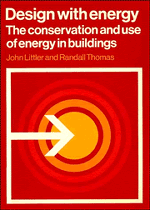Book contents
- Frontmatter
- Contents
- Units, symbols, abbreviations, conventions and conversion factors
- Preface
- 1 Energy and buildings
- 2 Site planning and analysis
- 3 Building design
- 4 Passive solar design
- 5 Active solar heating
- 6 Space heating and ventilation
- 7 Thermal storage
- 8 Wind energy
- 9 Water-supply systems
- 10 Waste disposal and utilization
- 11 Domestic-energy saving
- 12 Housing case studies
- 13 Non-domestic case studies
- Appendix 1 Weather data
- Appendix 2 Thermal performance
- Appendix 3 Interstitial condensation
- Index
11 - Domestic-energy saving
Published online by Cambridge University Press: 03 February 2010
- Frontmatter
- Contents
- Units, symbols, abbreviations, conventions and conversion factors
- Preface
- 1 Energy and buildings
- 2 Site planning and analysis
- 3 Building design
- 4 Passive solar design
- 5 Active solar heating
- 6 Space heating and ventilation
- 7 Thermal storage
- 8 Wind energy
- 9 Water-supply systems
- 10 Waste disposal and utilization
- 11 Domestic-energy saving
- 12 Housing case studies
- 13 Non-domestic case studies
- Appendix 1 Weather data
- Appendix 2 Thermal performance
- Appendix 3 Interstitial condensation
- Index
Summary
Introduction
Results from the recent Better Insulated Housing Programmed are summarized in Table 11.1 which shows the fractions of energy consumed onsite for various purposes.
The experimental houses at Bebington (Fig. 4.48), which are electrically heated, indicate that only about half the electricity supplied annually is used directly for space heating.
Much of the energy provided to the lights, fridge and so on, contributes usefully during the heating season to warming the space. Capper suggests the fractions shown in Table 11.2.
One might wish to argue a little with the low figures (Leach assumes 0.8 in all cases and Siviour's conclusions are shown in Table 3.1) but the fact remains that a substantial fraction of the heating in houses arises from electricity (or gas) used in appliances. Since this energy is wholly or partly electrical (generated with an efficiency of roughly 30%), the cost to the country in terms of primary fuel, or to the consumer in terms of cost, constitutes a large part of the annual fuel bill for each house. Thus, one would expect to find regulations concerning the efficiency of appliances. There are almost none in the UK, although in the US some goods must be marked with an efficiency indicator.
In the Bo'ness study, nearly all households have a clothes washer, one-third a tumble drier, all have a fridge and 40% have a freezer. Most have a colour television. Two-thirds of the households have electric fires, one-third have calor gas and one-fifth have paraffin heaters as subsidiary heating devices.
- Type
- Chapter
- Information
- Design with EnergyThe Conservation and Use of Energy in Buildings, pp. 304 - 309Publisher: Cambridge University PressPrint publication year: 1984



